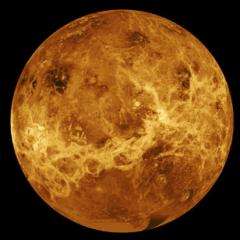Earth, Venus lightnings produced by similar mechanisms

Despite the great differences between the atmospheres of Venus and Earth, scientists have discovered that very similar mechanisms produce lightning on the two planets. The rates of discharge, the intensity and the spatial distribution of lightning are comparable, thus scientists hope to be able to better understand the chemistry, dynamics and evolution of the atmospheres of the two planets. These results were presented by Dr. Christopher Russell at the European Planetary Science Congress, on Thursday 23d September.
Early missions, such as the Venera orbiters and probes, followed later by the Pioneer Venus Orbiter and more recently by the Galileo spacecraft, have reported evidence for optical and electromagnetic waves from Venus that could be produced by lightning. This was also confirmed by ground telescopes capturing lighting flashes at Venus. Yet the differences in the two atmospheres led some to claim that lightning on Venus would be unlikely and the topic became controversial. The launch of Venus Express with its magnetometer built by the Space Research Institute in Graz, Austria, has provided a great opportunity to unambiguously confirm the occurrence of lightning on Venus and to study in detail its magnetic field at altitudes between 200 and 500 km.
“Short strong pulses of the signals expected to be produced by lightning were seen almost immediately upon arrival at Venus, despite the generally unfavorable magnetic field orientation for entry of the signals into the Venus ionosphere at the altitude of the Venus Express measurements,” says Dr. Russell of the University of California, USA. The electromagnetic waves that Dr. Russell and his team observed are strongly guided by the Venusian magnetic field and they can only be detected by the spacecraft when the magnetic field tilts away from the horizontal by more than 15 degrees. This is quite unlike the situation on Earth, where the lightning signals are aided in their entry into the ionosphere by the nearly vertical magnetic field.
When clouds form, on Earth or Venus, the energy that the Sun has deposited in the air can be released in a very powerful electrical discharge. As cloud particles collide, they transfer electrical charge from large particles to small, and the large particles fall while the small particles are carried upward. The separation of charges leads to lightning strokes. This process is important for a planetary atmosphere because it raises the temperature and pressure of a small portion of the atmosphere to a very high value so that molecules can form, which would not otherwise occur at standard atmospheric temperatures and pressures. This is why some scientists have speculated that lightning may have helped life to arise on Earth.
On our planet occur about 100 lightning discharges per second, but from any one location we see far fewer. Similarly on Venus we do not see the entire planet and we have to estimate the total occurrence rate with some assumptions about how far one can see. Thanks to the new datasets from Venus Express, Dr. Russel and colleagues were able to show that lightning is similar in strength on Earth and Venus at the same altitudes. “We have analyzed 3.5 Earth-years of Venus lightning data using the low-altitude Venus Express data (10 minutes per day). By comparing the electromagnetic waves produced at the two planets, we found stronger magnetic signals on Venus, but when converted to energy flux we found very similar lightening strength,” reports Dr. Rusell. Also it seems that lightning is more prevalent on the dayside than at night, and happens more often at low Venusian latitudes where the solar input to the atmosphere is strongest.
“Venus and Earth are often called twin planets because of their similar size, mass, and interior structure. The generation of lightning is one more way in which Venus and Earth are fraternal twins,” concludes Dr. Russell.
More information: Venus lightning: Comparison with terrestrial lightning, C.T. Russell, R.J. Strangeway, J.T.M. Daniels, T.L. Zhang, and H.Y. Wei, 2010, Planetary and Space Science (in press).
Provided by Europlanet

















